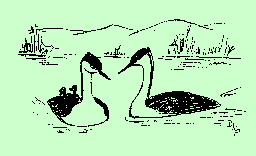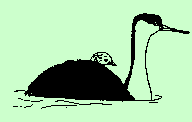|
The Western Grebe

 The scientific name of the Western Grebe, Aechmophorus (from a Greek
word meaning "one who carries a spear"), refers to the bird's sharp pointed
bill, and occidental means "western". Like the loons, they are
highly aquatic, powerful divers and swimmers. At any threat of danger, they
dive in a flash; or, if uncertain, quietly and slowly sink out of sight.
Their plumage is dense, soft and silky, and completely waterproof. Because
their feet are placed far back on the body, as in the loons, on land they
are very awkward and must skitter over the water a long distance to get
into the air. In flight, the wing beats are rapid; due to shortness of tail,
their feet, lobed but not webbed, act as a rudder.
The scientific name of the Western Grebe, Aechmophorus (from a Greek
word meaning "one who carries a spear"), refers to the bird's sharp pointed
bill, and occidental means "western". Like the loons, they are
highly aquatic, powerful divers and swimmers. At any threat of danger, they
dive in a flash; or, if uncertain, quietly and slowly sink out of sight.
Their plumage is dense, soft and silky, and completely waterproof. Because
their feet are placed far back on the body, as in the loons, on land they
are very awkward and must skitter over the water a long distance to get
into the air. In flight, the wing beats are rapid; due to shortness of tail,
their feet, lobed but not webbed, act as a rudder.


 The Western Grebe is the largest (22" to 29") of the grebes. It has an
extremely long swan-like neck. The general appearance is blackish above and
white below, with a straight or slightly upturned, light yellow bill.
The top of the head, back of the neck and back are black or very dark brown;
cheeks, neck and underparts are white.
The Western Grebe is the largest (22" to 29") of the grebes. It has an
extremely long swan-like neck. The general appearance is blackish above and
white below, with a straight or slightly upturned, light yellow bill.
The top of the head, back of the neck and back are black or very dark brown;
cheeks, neck and underparts are white.

 Spring migration begins in April in Utah. Breeding grounds are in fresh
water where vegetation provides cover and nesting material and food. The
diet includes minnows, other small fish, crustaceans (including crayfish
where available), aquatic insects, and other aquatic life. Strangely, all
grebes, both young and adults, eat their own feathers, retaining them in a
tight ball in their stomachs until digested enough to pass through the
lower intestinal tract. It is thought that these clumps may hold back such
objects as fish bones until they are softened by the digestive juices of
the stomach.
Spring migration begins in April in Utah. Breeding grounds are in fresh
water where vegetation provides cover and nesting material and food. The
diet includes minnows, other small fish, crustaceans (including crayfish
where available), aquatic insects, and other aquatic life. Strangely, all
grebes, both young and adults, eat their own feathers, retaining them in a
tight ball in their stomachs until digested enough to pass through the
lower intestinal tract. It is thought that these clumps may hold back such
objects as fish bones until they are softened by the digestive juices of
the stomach.

 Few water birds match the Western Grebe for showmanship at mating time.
They engage in strange performances or races. Two birds, usually a pair
(but also may be of the same sex, or more than two), approach each other,
heads low, throats swollen, red eyes bulging, crests erect. They dip their
bills in the water and shake them with a rapid clicking. Then suddenly,
as if on a signal, they turn sideways, rise upright, arch their wings,
bend their necks in an "S" curve, and dash ahead seeming to run upon the
water. Then they dive, emerge, and swim sedately abreast. This performance
is repeated many times. It seems to be some kind of a social ceremony that
releases nervous energy.
Few water birds match the Western Grebe for showmanship at mating time.
They engage in strange performances or races. Two birds, usually a pair
(but also may be of the same sex, or more than two), approach each other,
heads low, throats swollen, red eyes bulging, crests erect. They dip their
bills in the water and shake them with a rapid clicking. Then suddenly,
as if on a signal, they turn sideways, rise upright, arch their wings,
bend their necks in an "S" curve, and dash ahead seeming to run upon the
water. Then they dive, emerge, and swim sedately abreast. This performance
is repeated many times. It seems to be some kind of a social ceremony that
releases nervous energy.

 Grebes are gregarious and nest in large colonies out in the waters of
shallow lakes or swamps and marshes. After mating, both birds cooperate in
building a wet, semi-floating nest of plant debris. Both parents incubate
the three to six bluish white eggs. Incubation begins with laying of the
first egg, and lasts about 23 days. The chicks hatch on successive days,
yet the latest gets as much attention as the eldest. The young are pale
gray with short thick velvety down. They feed themselves from the beginning.
When all are hatched, the parents often carry them piggyback, and may dive
with their young held in place under the fold of the wings. The babies come
loose and pop to the surface like downy corks.
Grebes are gregarious and nest in large colonies out in the waters of
shallow lakes or swamps and marshes. After mating, both birds cooperate in
building a wet, semi-floating nest of plant debris. Both parents incubate
the three to six bluish white eggs. Incubation begins with laying of the
first egg, and lasts about 23 days. The chicks hatch on successive days,
yet the latest gets as much attention as the eldest. The young are pale
gray with short thick velvety down. They feed themselves from the beginning.
When all are hatched, the parents often carry them piggyback, and may dive
with their young held in place under the fold of the wings. The babies come
loose and pop to the surface like downy corks.

 -- by Marie L. Atkinson -- by Marie L. Atkinson
REFERENCES:
Field Guide to Western Birds
Roger Tory Peterson

National Geographic
George Miksch Sutton
|
|

